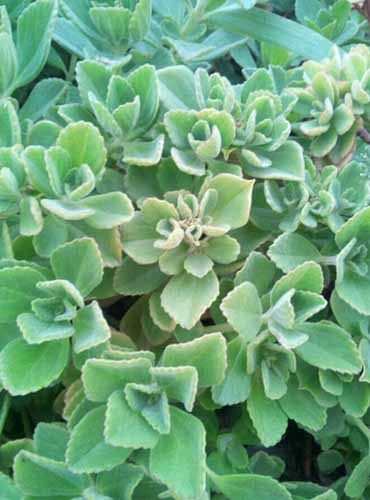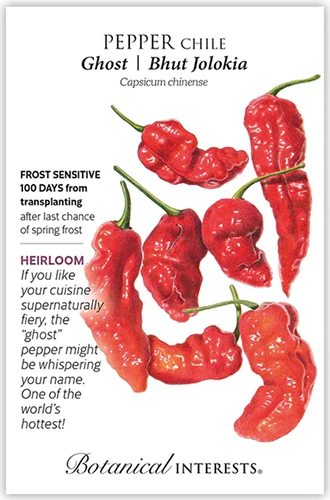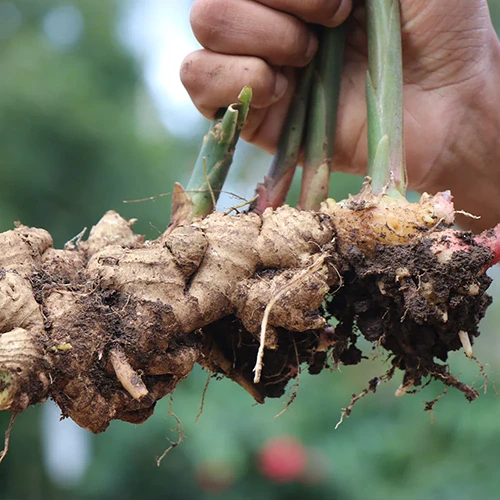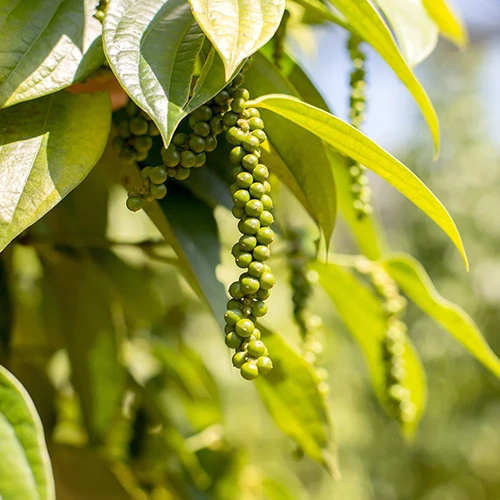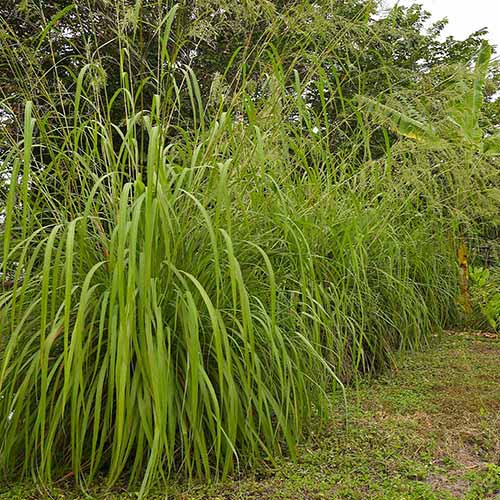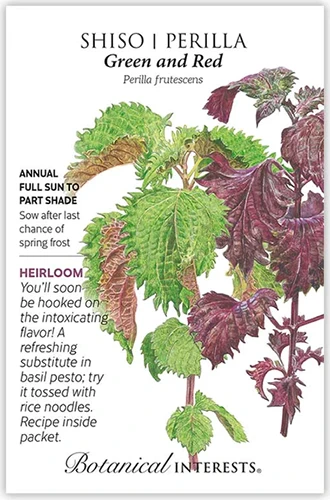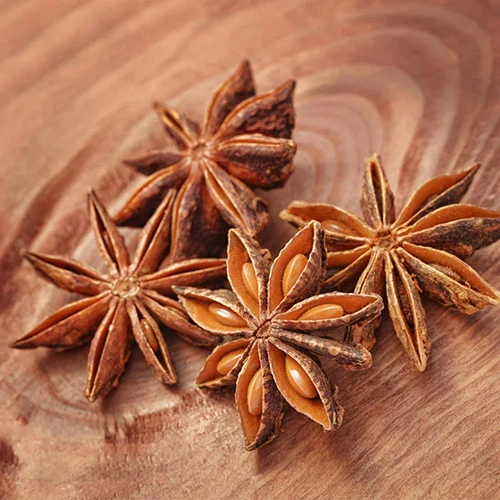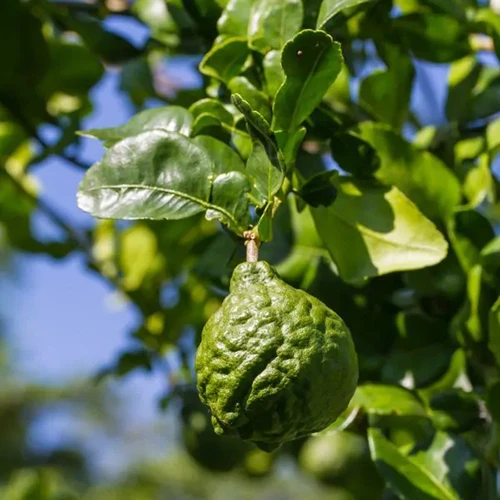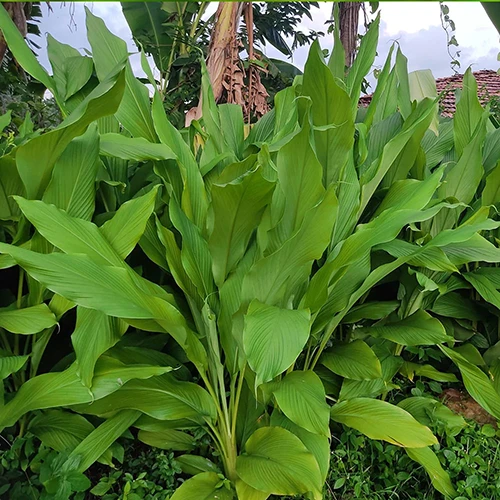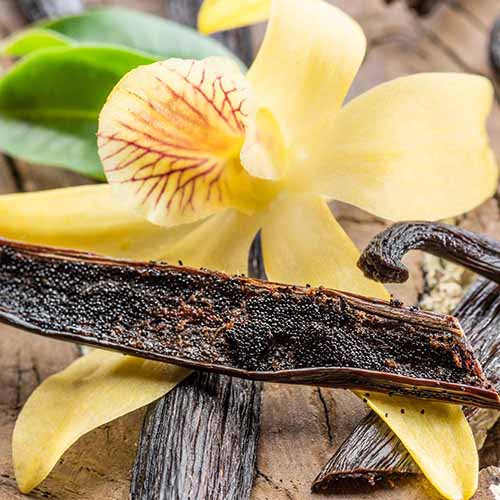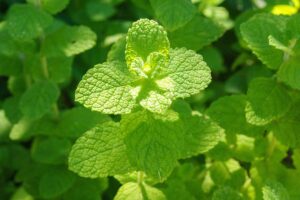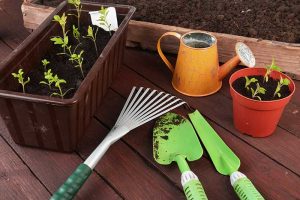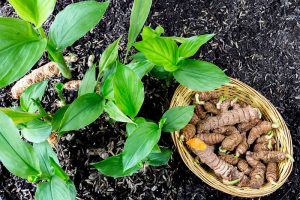Tropical herbs and spices transport us to sunnier climates with their intriguing flavor profiles.
Growing different types of tropical herbs and spices in the yard or garden can open up new possibilities for your culinary creations – and help you recreate some of your favorite restaurant meals at home.
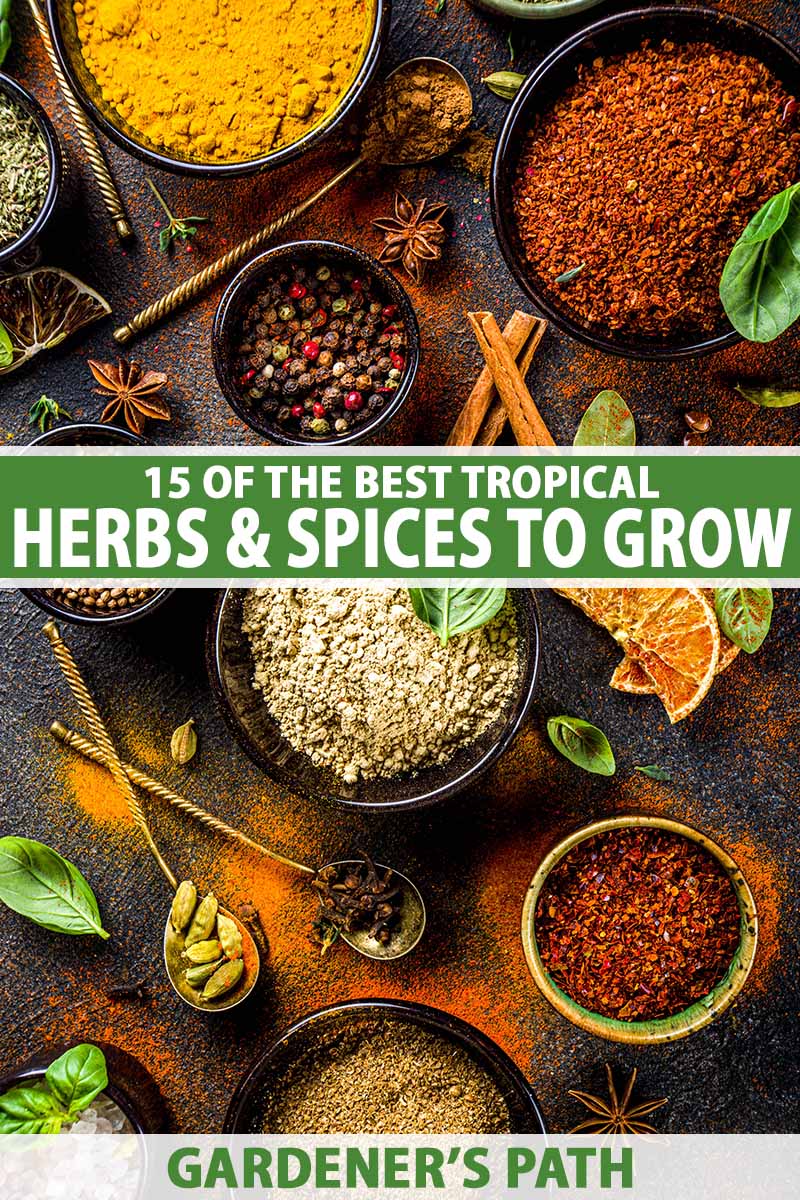
We link to vendors to help you find relevant products. If you buy from one of our links, we may earn a commission.
You may not even be able to find some of these seasonings at your local supermarket, but chances are, you can grow these warming rhizomes, flavorful leaves, and spicy seeds in the garden!
Whether you’re a gardener located in a tropical or subtropical location, or a temperate zone gardener interested in expanding your herb garden to include some heat-loving plants to overwinter indoors, read on to discover 15 different tropical seasonings you can grow at home.
15 Tropical Herbs and Spices for the Garden
1. Cardamom
The first tropical spice to consider for your garden is cardamom.
This plant is a member of the ginger family or Zingiberaceae, a plant family known for counting among its ranks several delicious culinary spices.
E. cardamomum, the species we’re focusing on here, is also called “green cardamom” or “true cardamom.” There is also a black cardamom (Amomum subulatum) which has a smokier flavor.
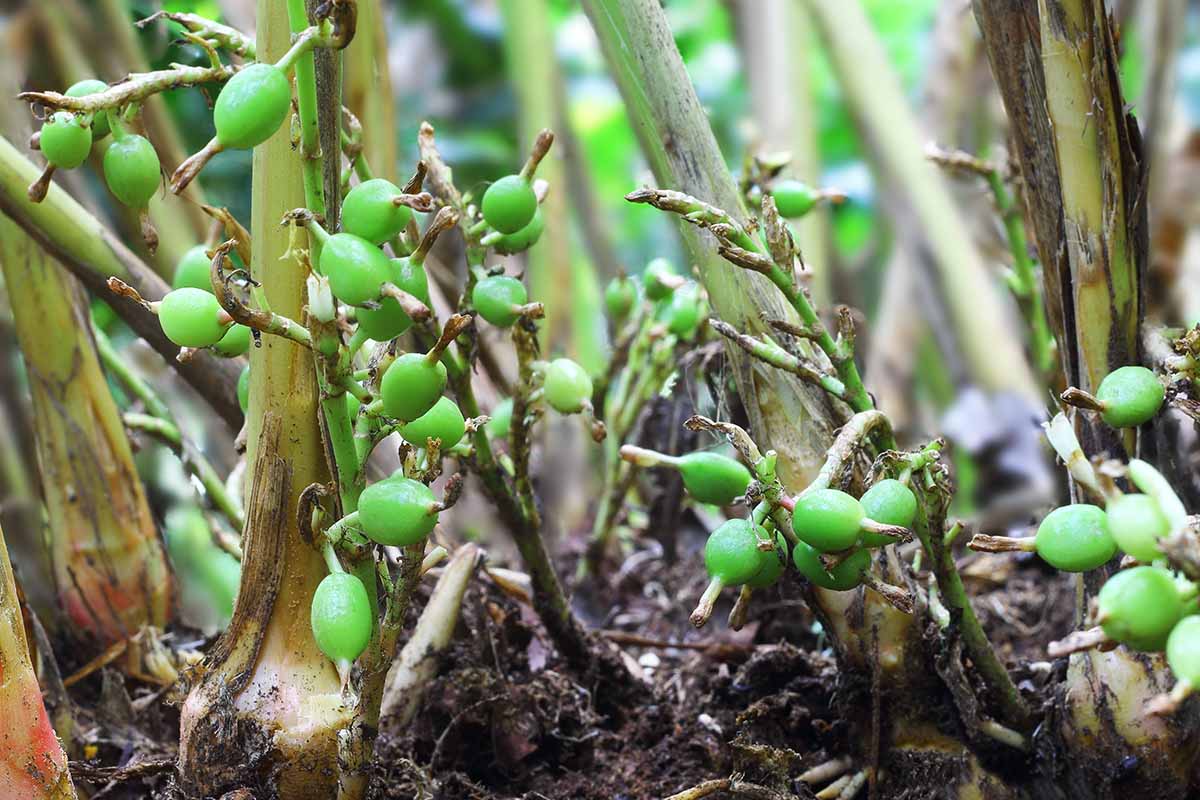
The true cardamom plant has long, green leaves emerging from long stems. These tropical plants can reach five to 10 feet tall.
They produce beautiful flowers followed by green fruits that ripen to form delicious cardamom seed pods – the part of the plant used as a spice.
To care for this tropical spice-producing plant in the garden, provide it with dappled sunlight and consistently moist soil.
Cardamom can be grown outdoors year round in USDA Hardiness Zones 10 to 13, but it is also easy to cultivate this spice as a houseplant, as long as it has adequate humidity.
Keep in mind that it takes established plants three to five months to bring seeds to maturity after flower set.
You may be familiar with cardamom as a spice used in savory Indian dishes such as biryani, but this tropical spice is also delectable in sweet baked goods.
If you’d like a taste of what’s in store when you harvest your own supply of cardamom, feast your eyes on this recipe for sweet and crunchy cardamom saffron cookies from our sister site, Foodal.

Psyched to grow your own stash of cardamom in the garden? Packs of 10 cardamom seeds are available via Amazon.
Learn more about growing cardamom in our article.
2. Cuban Oregano
Our next selection for the garden is one you may not realize is a tropical herb!
Cuban oregano (Coleus amboinicus) is a tropical member of the mint family or Lamiaceae, closely related to the colorful coleus plants you may use as annual bedding plants.
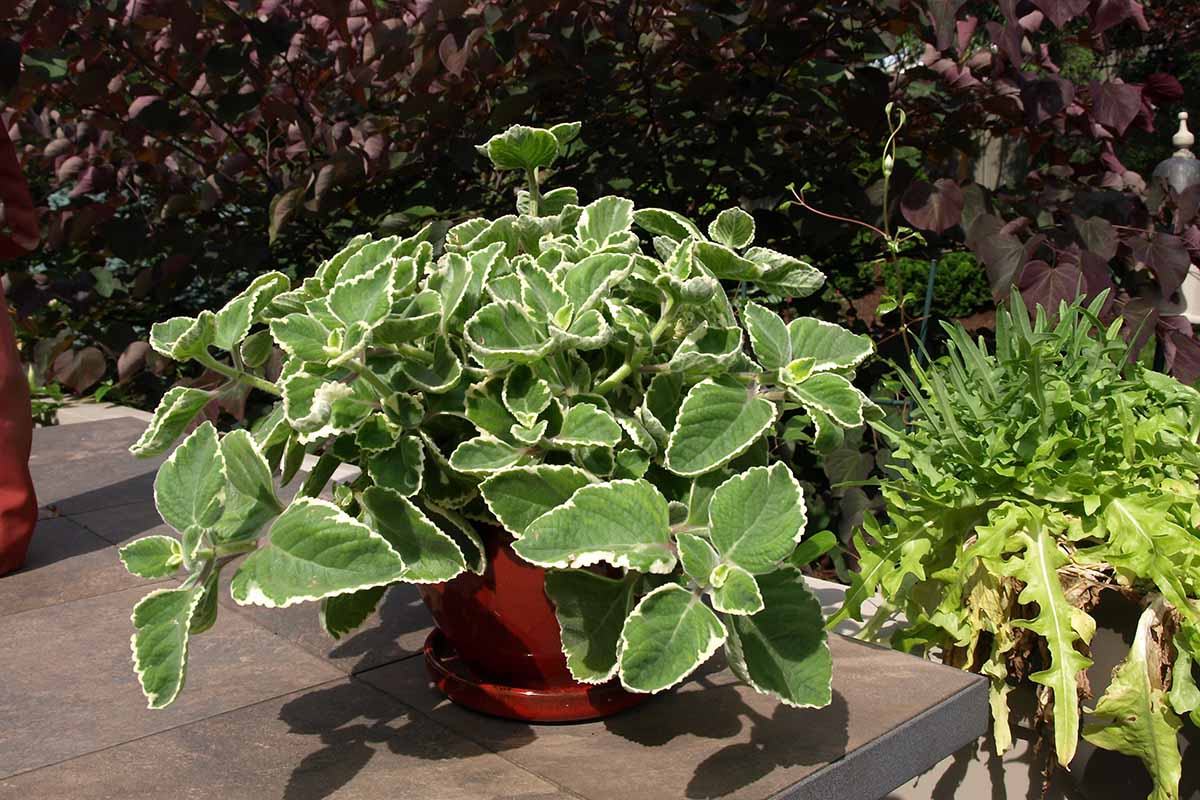
With mint-like, opposite leaves that are thick and velvety, Cuban oregano plants grow to be one to three feet tall with a one- to two-foot spread. You may be most familiar with the variegated form of this tropical herb.
In the garden, keep Cuban oregano in partial shade, preferably with sun in the morning and shade in the afternoon, and water when the top inch of soil has dried.
Sometimes called “Mexican mint,” this tropical herb can be cultivated outdoors in USDA Hardiness Zones 9 to 11, but it is also easy to care for Cuban oregano indoors.
Trim one-inch segments to use in the kitchen once plants are established after transplanting.
Cuban oregano can be used to season sofrito, pasta dishes, and Tex-Mex style meals, and it has a flavor much like common oregano (Origanum vulgaris) but with a more of a punch.
Sourcing Cuban oregano seeds is tricky, so this herb is usually propagated via division or cuttings. You will be more likely to find live plants for the garden than seeds.
Set of Two Live Cuban Oregano Plants in 4” Pots
You can purchase a set of two starter Cuban oregano plants in four-inch pots from Daylily Nursery via Walmart.
Learn more about growing Cuban oregano in the garden in our article.
3. Culantro
Culantro brings us to our next tropical herb. And if you did a double take as you read the title of this selection for the garden – no, you haven’t stumbled upon a typo.
Like its similarly named relative cilantro, culantro (Eryngium foetidum) is an herb from the carrot family.

This tropical herb also has a similar flavor profile to cilantro. Unlike that cool-season plant however, this herb thrives in weather that would cause cilantro to bolt and its leaves to go bitter.
Also known as “Mexican coriander” and “spirit weed,” though the taste of this herb is a close match to cilantro, it doesn’t have much in common appearance-wise – culantro has long, narrow leaves with serrated edges.
This tropical herb reaches one and a half to two feet tall.
When it comes to caring for this herb in the garden, locate culantro in part shade, and keep the soil moderately moist.
Grown from seed, this tropical herb will mature in 80 or 90 days. These plants are considered perennial in USDA Hardiness Zones 7 to 11.
Culantro will perform beautifully as a cilantro alternative in Asian or Latin American style dishes.

Stock up on 300-seed packs from the Seed Needs Store to grow your own culantro, available via Amazon.
4. Curry Leaf Tree
Our next selection for the garden is a tropical herb that provides a familiar name in what may be an expected form.
In the cuisines of certain regions of India, the leaves of the curry leaf tree (Murraya koenigii) are a common seasoning – but one you may not find for purchase at your local supermarket.
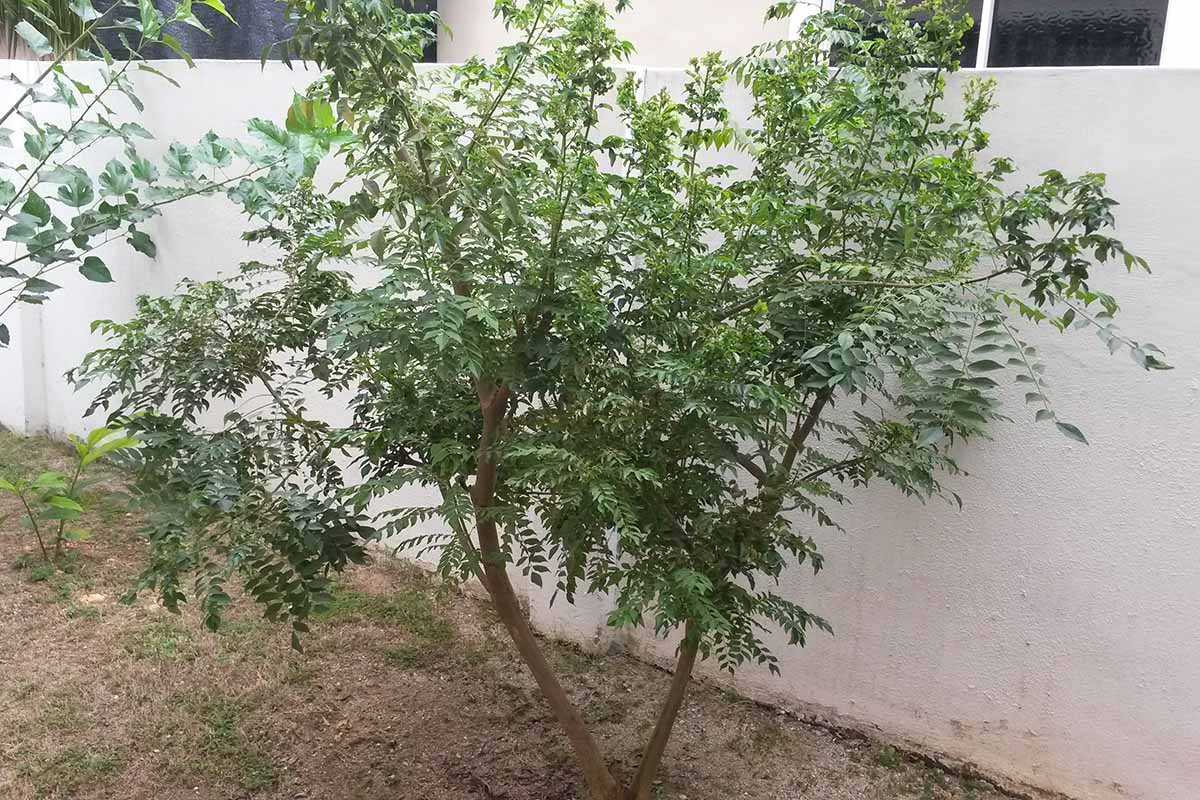
While you may expect the leaves of the curry tree to be an ingredient in the spice mix known as “curry powder” – surprisingly, they’re not!
While some people find that curry leaves have an earthy, curry-like flavor, others notice more of a citrus taste.
So perhaps it’s not surprising then that this species is a member of the citrus family – just like limes and lemons.
This small tree reaches six to fifteen feet tall with a spread of four to 12 feet. It bears compound leaves with 11 to 21 delicious leaflets per stem.
In the garden, keep curry leaf trees in full sun, or part shade in hot weather or locations. Allow the soil to dry to the touch between waterings.
These trees reach mature size in two to five years, depending on the variety, but can be sparingly harvested starting at one year old.
This tropical tree can be cultivated outdoors year round in USDA Hardiness Zones 9 to 12.
Curry leaves are used as a seasoning in the cuisines of South and Southeast Asia. Curry leaf lassi, anyone?
Can’t wait to cultivate your own homegrown supply of curry leaves? You can purchase a bare root, two- to three-inch-tall curry leaf tree via Walmart.
For more tips and guidance on growing curry leaf trees, read our article!
5. Galangal
This next selection brings a fresh option for garden-grown spice.
Galangal (Alpinia galanga) is a tropical spice that’s frequently used in Thai and Vietnamese food. You might not recognize it on your plate, but it imparts a unique citrusy flavor.
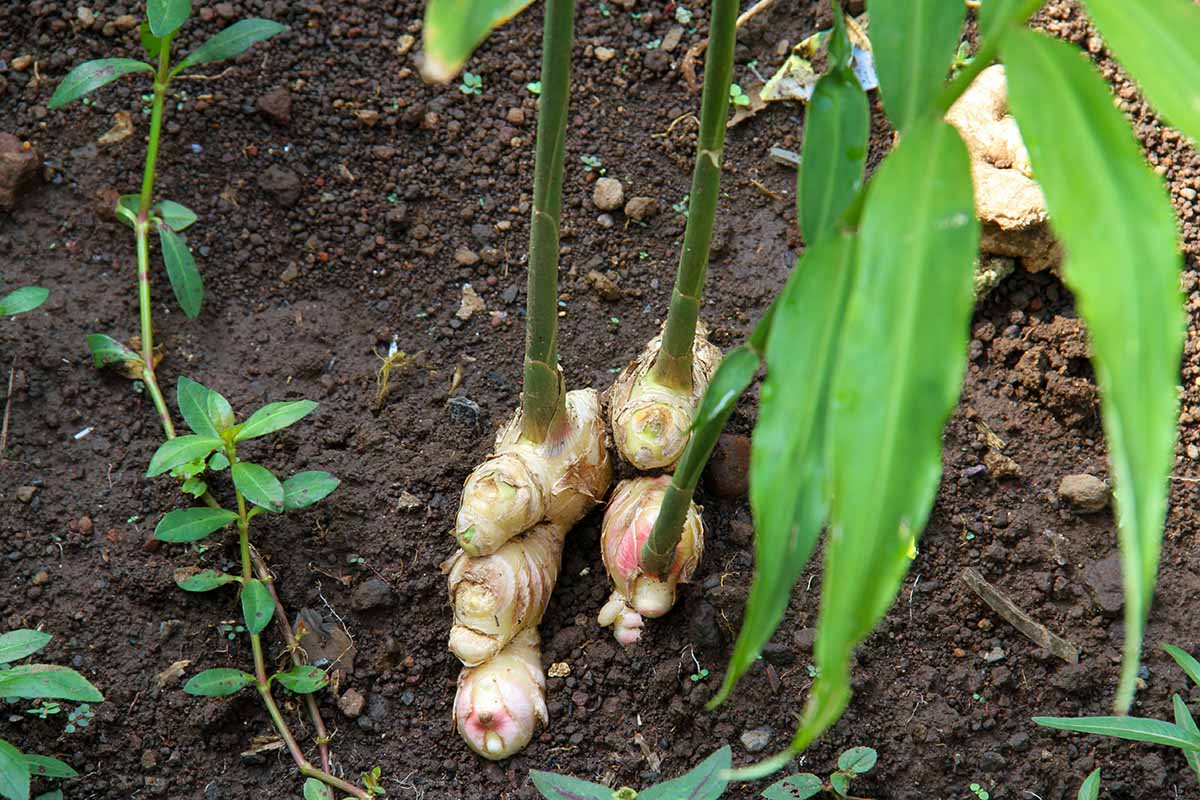
Also known as “Thai ginger,” galangal is one of the fabulous, spice-producing members of the ginger family I mentioned earlier in this article. Galangal is cultivated for its flavorful rhizomes.
Galangal plants bear long leaves that are widely spaced on upright stalks, and can reach over six feet in height.
Hardy in the garden year round in USDA Zones 9 to 12, galangal requires moist soil and thrives in part shade.
When cultivated from rhizomes, count on waiting about three months until harvest for this spice.
This tropical spice is a staple in Cambodian, Malaysian, Thai, and Vietnamese cuisine. Spice your next coconut soup with a slice or two of the rhizome and savor the flavor!

Want to be able to harvest your own galangal from your garden to use as a spice?
You’ll find fresh galangal rhizomes for purchase in quantities of one or two pounds from Kejora via Amazon.
You can learn to propagate and grow galangal in our handy guide!
6. Ghost Pepper
Ready to shift to another meaning of the word “spice” and turn up the heat in your garden?
For some of us, a meal isn’t really satisfying without the inclusion of some capsaicin, and the ghost pepper (Capsicum assamicum) certainly packs it, coming in at over one million Scoville heat units.
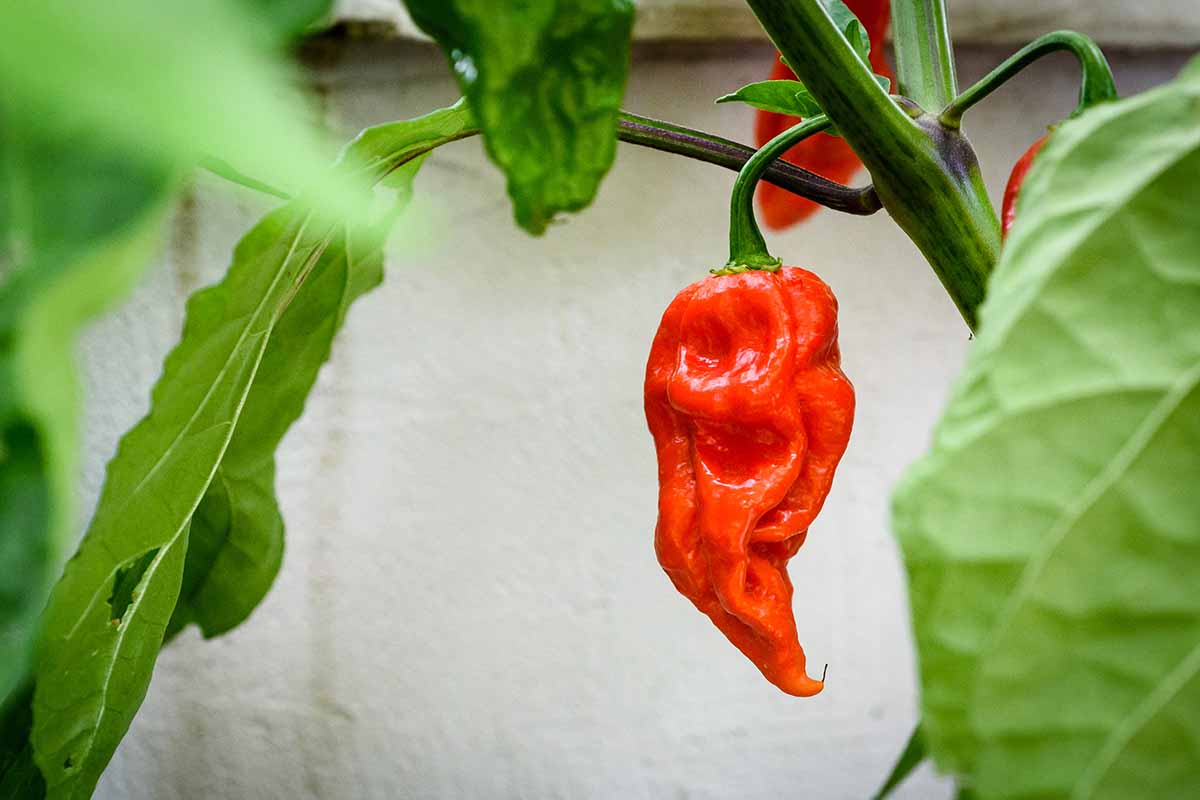
Also known as “bhut jolokia” or “naga jolokia,” the ghost pepper is a member of the nightshade family, which includes tomatoes, eggplants, and potatoes as well as bell peppers and other hot peppers.
Ghost peppers reach up to four feet in height and have lance-shaped leaves, bearing peppers that are tapered and wrinkly, maturing from green to orange to red – and brimming over with spicy capsaicin.
These tropical peppers thrive in hot, humid conditions, require a long growing season, and are considered tender perennials in USDA Hardiness Zones 8 to 11.
In the garden, locate ghost peppers in full sun, plant in well-drained soil, and water when soil is dry one inch deep.
Expect a harvest of this tropical spice 120 to 150 days from transplanting.
If you are a chili head like me, I doubt you’ll need suggestions on how to use this hot pepper. It’s the perfect option to elevate a bowl of beans and rice or spice up some scrambled eggs.
What better way to start the day than with a kick of intense heat?
Whatever your intended use for this hot pepper, be sure to start off with small amounts – it’s a blazing forest fire in a tiny package.
Ghost Pepper Bhut Jolokia Seeds
You can purchase packs of 15 ghost pepper seeds from Botanical Interests.
Or maybe you want to skip the seed starting and get down to business with spice-producing plants for the garden?
Purchase a two-pack of live ghost pepper starter plants from Bonnie Plants via Walmart.
You’ll learn more about growing and harvesting ghost peppers in our complete guide!
7. Ginger
This next spice option is a great companion plant for galangal and cardamom in the garden.
Zingiber officinale is the tropical plant that lends its name to the delectable and delightful Zingiberaceae, also known as the ginger family.
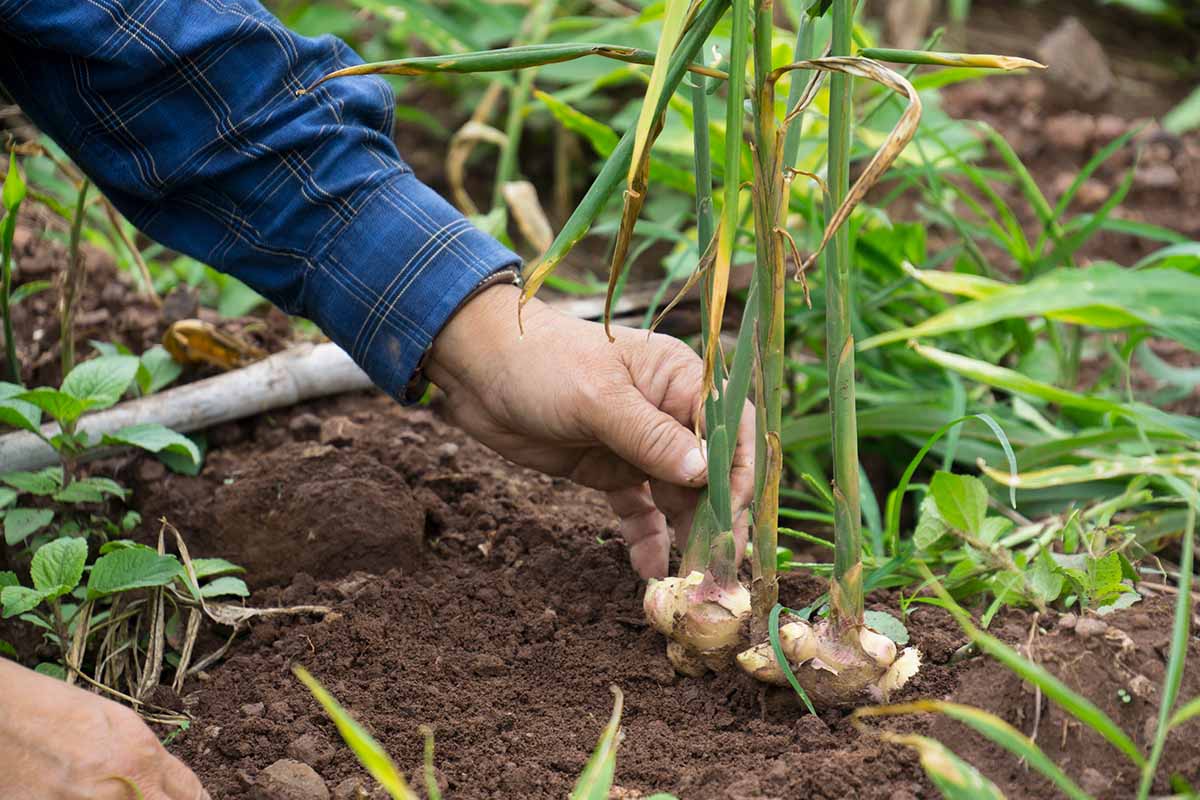
Ginger plants produce a rhizome used to flavor many a stir fry, but also culinary delights as diverse as gingerbread and ginger beer – and you can grow your own supply of this tropical spice!
Reaching a little over three feet tall and bearing narrow leaves, this tropical plant’s edible rhizome, the source of the ubiquitous ginger spice, is also known commonly as “ginger root.”
This tropical spice can be cultivated in the garden year round in USDA Hardiness Zones 9 to 12, but ginger can also be grown indoors.
To care for ginger, plant in part shade and keep the soil moist. Plan on waiting about eight to 10 months from planting rhizomes until your spice crop is ready to harvest.
Ginger has so many culinary uses that you might not realize just how pervasive this spice is in various cuisines across the world.
Whether it’s picked and used as a garnish for Japanese sushi, a seasoning in Indian dal, or as a spice in Dutch speculaas cookies, this rhizome crop has a widespread and established presence in the culinary world.
Speaking of cookies, if you suddenly have a hankering, check out this recipe for big and soft ginger cookies from our sister site, Foodal.
Use the store bought spice for this batch of cookies if you must, but start cultivating your own homegrown ginger root in the garden to flavor cookies truly made from scratch.
You can purchase live ginger plants in one-gallon or three-gallon pots from Fast Growing Trees.
Check out our complete guide to growing and harvesting ginger in the home garden.
8. Green Peppercorn
Our next tropical herb for the garden offers a new look at a familiar spice.
While once considered a luxury item, black peppercorns are so commonplace these days that we expect to have a shaker or grinder of this spice sitting on every restaurant table to use free of charge.
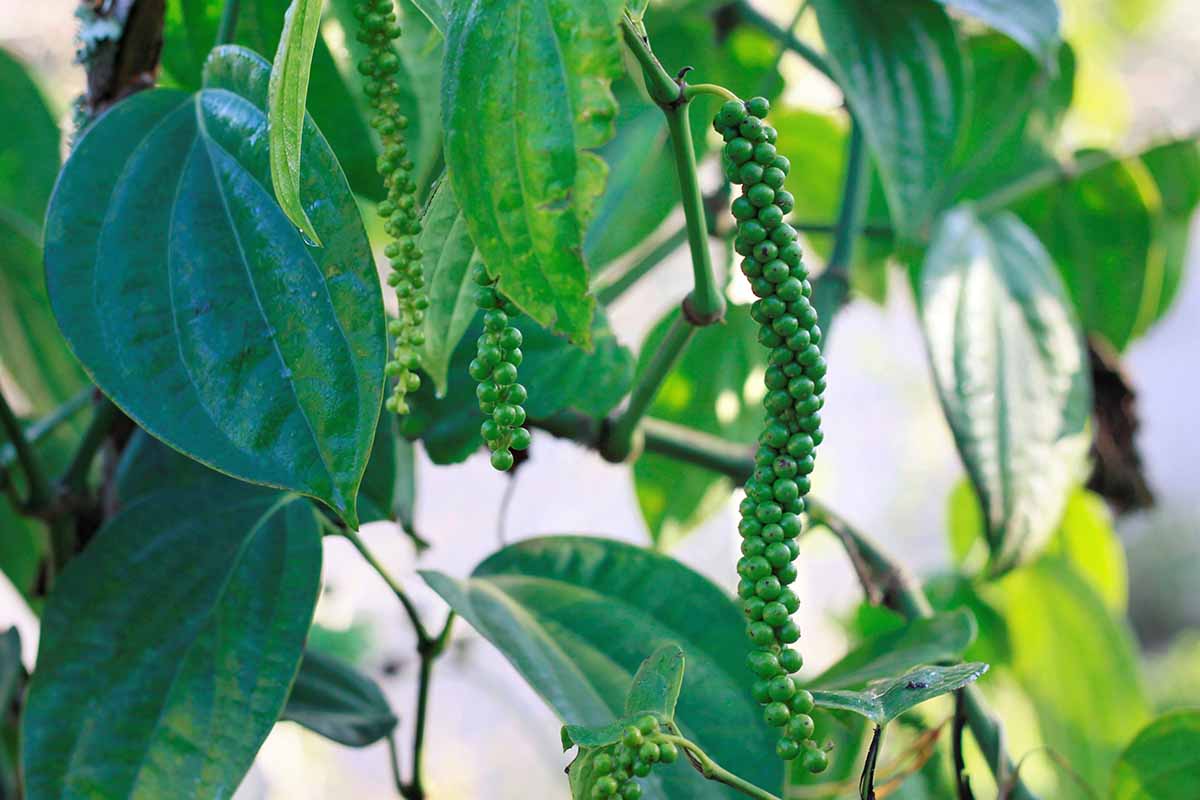
Though the dried peppercorns of Piper nigrum would hardly be considered a luxury ingredient anymore, fresh green peppercorns, on the other hand, offer a mind-blowing taste sensation that’s hard to come by.
Yes, these are the same peppercorns, only fresh rather than dried.
Peppercorns are grown commercially in tropical locales and don’t hold up long in their fresh form, so you won’t be likely to see this spice in the refrigerated section of the average North American grocery store.
Grow your own crop of this tropical spice, however, and the problem is solved!
A member of the Piperaceae family related to peperomias, P. nigrum is a vining tropical plant that produces long clusters of drupes – we know these as peppercorns.
Its leaves are heart shaped, and its vines can reach 30 feet long.
If you’d like to cultivate this vining, tropical plant in the garden for a supply of your own fresh green peppercorns, know that the vines can be grown outdoors year round in USDA Hardiness Zones 10 to 11.
Black peppercorn plants should be placed in part sun (or full sun in milder climates), in soil that is moist and well-draining.
Be patient – the vines of this tropical spice producer only start bearing fruit after four to five years.
Personally, I lean towards a plant-based diet these days, but I have to say, fresh green peppercorns are scrumptious when included in a creamy pan sauce and poured over chicken or steak.
As an alternative to animal protein, mushrooms also provide a harmonious flavor combination with this spice.
To start growing your own supply of green (or black!) peppercorns, you’ll find P. nigrum plants in one- or three-gallon pots from Fast Growing Trees.
9. Lemongrass
For those who love citrus flavors that are gardening in small spaces and need the option of compact plants, this next tropical herb will be of interest.
Lemongrass (Cymbopogon citrates) is – as you would expect – a grass, but one that is extremely flavorful.

This member of the grass family or Poaceae is also known as “oil grass” in reference to its aromatic essential oils, the compounds responsible for making this tropical herb so flavorful.
The long, thin blades of lemongrass can reach up to four feet long at full size.
Lemongrass is cultivated in full sun in moist, well-draining soil, and needs water when the top inch of the soil is dry.
This tropical herb can be grown in the garden year round in USDA Hardiness Zones 8b to 11b. Seed-grown specimens will reach maturity in 75 to 100 days.
Lemongrass is used in many cuisines of Southeast Asia. It pairs beautifully with coconuts and peanuts in soups, noodle dishes, and curries.
Ready to grow your own pot of this tropical herb in the garden? Find plants available at Fast Growing Trees.
You can also purchase a live 18- to 30-month-old lemongrass specimen from Nature Hills Nursery.
Need more tips on growing and harvesting this flavorful tropical grass? Read our complete guide to growing lemongrass.
10. Shiso
Our next selection is a tropical herb with an incomparable flavor.
Shiso (Perilla frutescens) is a subtropical to tropical herb that is easy to grow all year in USDA Hardiness Zones 10 to 11, or as a summer annual in cooler locations.
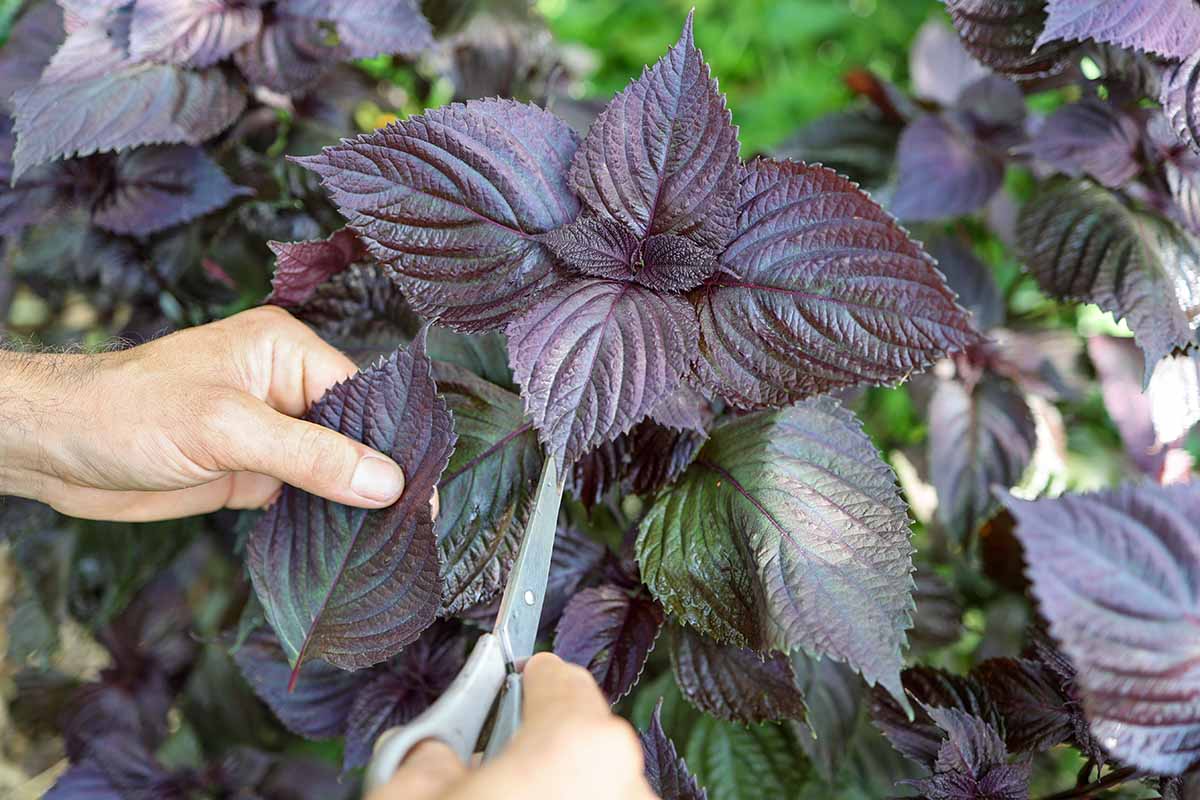
Also known as “perilla,” “beefsteak plant,” or “perilla mint,” shiso is a member of the mint family related to herbal staples such as basil, peppermint, and rosemary.
Shiso reaches up to three feet tall with a one-and-a-half-foot spread. The green or purple leaves of this herb are oval shaped, wrinkled, and have serrated edges.
In the garden, shiso thrives in full sun or part shade and prefers well-drained soil.
The leaves of this herb can be picked sparingly as soon as young plants are a few inches tall, and more established plants can be harvested at will.
Shiso is listed as an invasive species in some locations, so be sure to check with your local extension office before growing it.
When it comes to flavor, perilla seems to be the inkblot test of herbs – ask 10 people what it tastes like, and you might get 10 different answers!
Some folks notice citrus or mint flavors, others may detect cinnamon and celery. The flavor I notice the most when partaking in shiso is similar to that of cumin.
While the leaves are fun to use as mini wraps, they can also be mixed into noodle dishes or used in pickle preparations.
In one of my most memorable encounters with this herb I was served a single, delicate fried shiso leaf on top of a sushi roll.
Red and Green Shiso Packs of 280 Seeds
Decide for yourself about the flavor of this tasty tropical herb! You’ll find shiso for purchase in packs of 280 seeds at Botanical Interests.
11. Star Anise
For those with room to spare in the herb garden, try this next option for a spice that comes in a beautiful package.
If you are a fan of all things licorice or anise flavored, you may want to consider growing star anise (Illicium verum) in your tropical spice and herb garden.
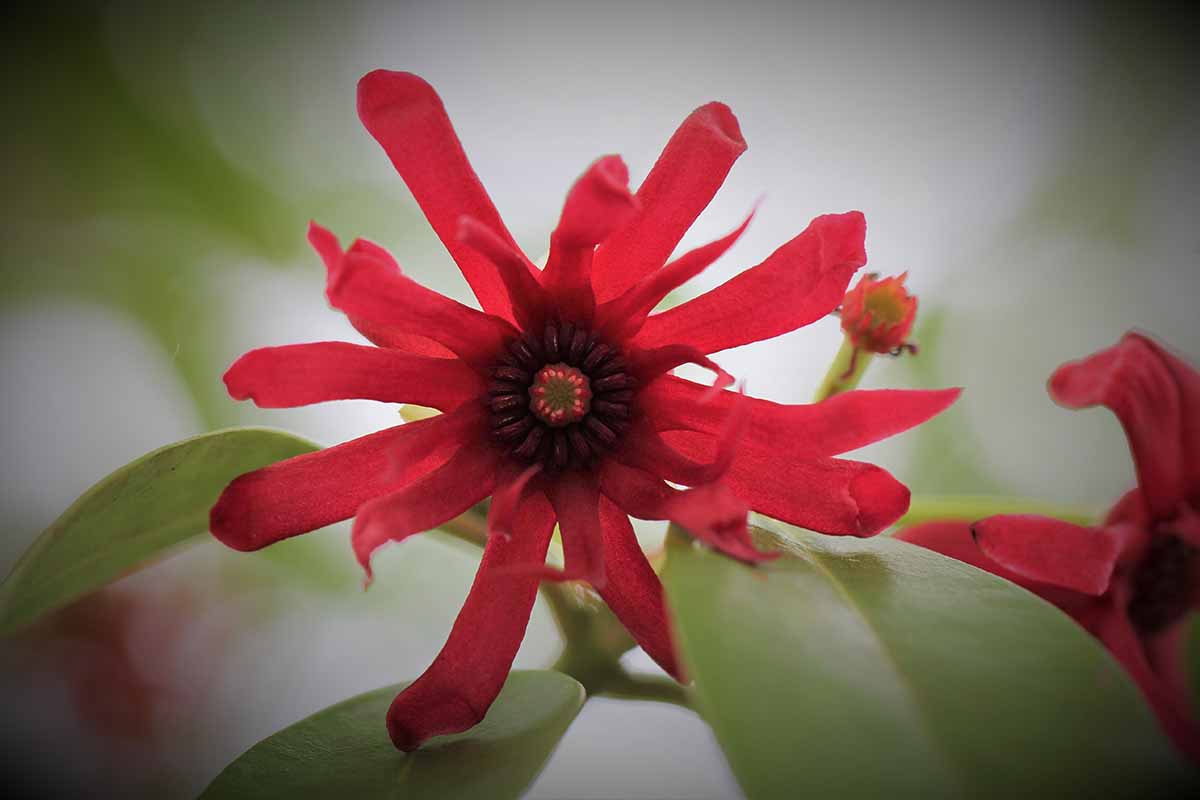
Also known as “badian,” and not to be confused with aniseed (Pimpinella anisum), star anise is a small evergreen tree with oval, elliptical, or lance-shaped green leaves and striking pink or red flowers.
This tropical tree produces star-shaped, seed-filled fruits that are dried and used as spice.
Star anise trees grow to be 10 to 20 feet tall and five to 10 feet wide.
In the garden, grow star anise in light, dappled shade, or sun in the morning followed by midday and afternoon shade. Water when the top two inches of soil are dry.
Star anise can be cultivated outdoors year round in USDA Hardiness Zones 8 to 11, and will begin to produce fruit for harvesting as spice at about five years of age.
This tropical spice is one of the ingredients in the Chinese spice mix known as “five spice powder.” It can also be used to flavor pho, a popular Vietnamese soup.
If you’d like to learn more about how to use star anise in the kitchen, be sure to check out Foodal’s article on the differences between aniseed and star anise.
Ready to start producing your own star anise spice? Get a head start on this gardening adventure with a live plant, available for purchase at Fast Growing Trees.

Prefer to start with seeds? You’ll find packs of 15 star anise seeds from Chuxay Garden via Amazon.
12. Thai Lime
Looking for more trees to grow in the garden with star anise? Consider Thai lime.
Thai lime (Citrus hystrix) is a small tropical tree in the citrus family whose leaves and fruit are both used to season foods.
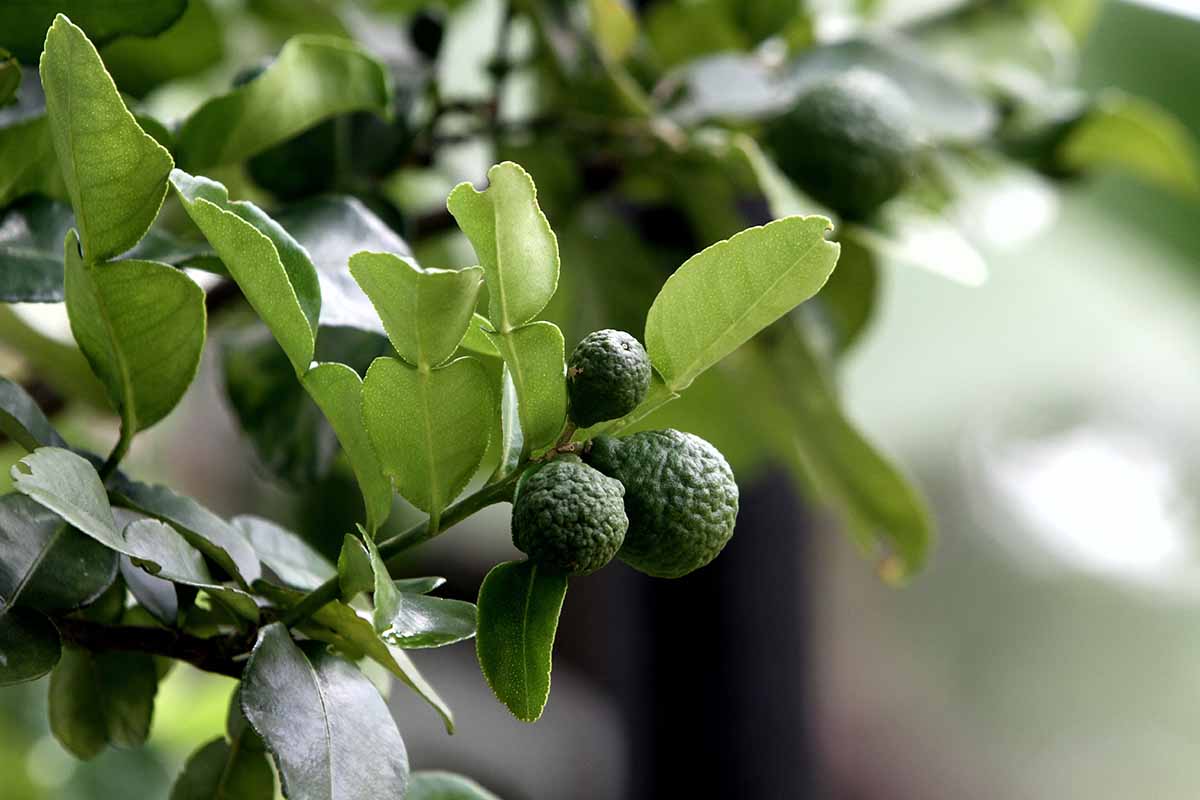
(You may know this seasoning by the name “kaffir lime” – but since this term is used as a pejorative in some locations, we’re opting for a less offensive name instead.)
Also known as “makrut lime,” this citrus tree reaches 10 to 12 feet tall and has a spread of five to six feet at maturity.
It bears unusual, double-lobed leaves and wrinkled, round, green fruits – both of which impart a distinctive aroma to foods.
When using the fruits, both juice and zest can be used culinarily as seasonings, or the fruit may be dried and used as a spice.
These dwarf trees require full sun and should be watered when the top inch of the soil is dry. Thai lime trees can be cultivated in the garden year round in USDA Hardiness Zones 9 to 11.
The time to maturity will depend on what size tree you start with – be sure to allow these young tropical trees to get established before allowing them to fruit, which may take four years or more.
Thai lime leaves and fruits have a flavor that leans more towards lemongrass than lime but is truly unique.
If you’ve ever eaten tom yum soup from your favorite Thai restaurant, you’ve likely already experienced the flavor of makrut lime leaves!
Both leaves and fruit are used throughout Southeast Asia, so get ready to season your curries and noodle or rice dishes with their remarkable flavor.
3-5 Year Old Live Thai Lime Tree
Grow your own makrut lime tree – you can purchase live plants that are three to five years old from Nature Hills Nursery.
You can learn more about growing and harvesting dwarf citrus trees in our article.
13. Turmeric
Our next garden option is a spice that doubles as a supplement – perhaps we should call it a super spice.
Formerly known by some as “just one of those ingredients in curry powder,” turmeric has risen in popularity in North America in recent years due to its reputation as an anti-inflammatory spice and supplement.

A member of the ginger family like cardamom, ginger, and galangal, turmeric (Curcuma longa) is a tropical species that reaches three to four feet tall and wide, and bears eye-catching flowers.
However it’s the rhizome of the plant that is used as a culinary spice.
In USDA Hardiness Zones 8 to 11, this tropical spice can be cultivated in the ground. Gardeners in cooler locations can grow it in containers and overwinter it indoors.
In the garden, grow turmeric in full or part sun, in well-draining soil. These plants need an inch of water per week on average.
Count on waiting seven to 10 months for harvestable rhizomes.
Turmeric is a core seasoning in Indian cuisine, and it’s also used in Thailand, Vietnam, and Cambodia.
And if you haven’t heard of “golden milk” or “golden tea,” recipes in which this spice has a starring role, where have you been?
Get up to date and check out a tasty recipe for Krishna’s golden turmeric tea from our sister site, Foodal.
If you’re ready to grow your own turmeric, it’s easy to start a plant from a rhizome, but these tropical wonders can also be purchased as leafed-out plants.
Turmeric Plant in 3-Gallon Pot
Bring home an established turmeric plant in a three-gallon nursery pot – you’ll find them at Fast Growing Trees.
Learn more about growing, harvesting, and propagating turmeric in our dedicated guide!
14. Vanilla
Don’t skip this next spice selection because it’s too familiar for your garden – instead, keep reading and you might see it in a new light.
If you think vanilla is too humdrum to be fancy, perhaps you haven’t been indulging in the delights of whole vanilla pods, a spice so exquisite that it tastes entirely different from the bottled extract.
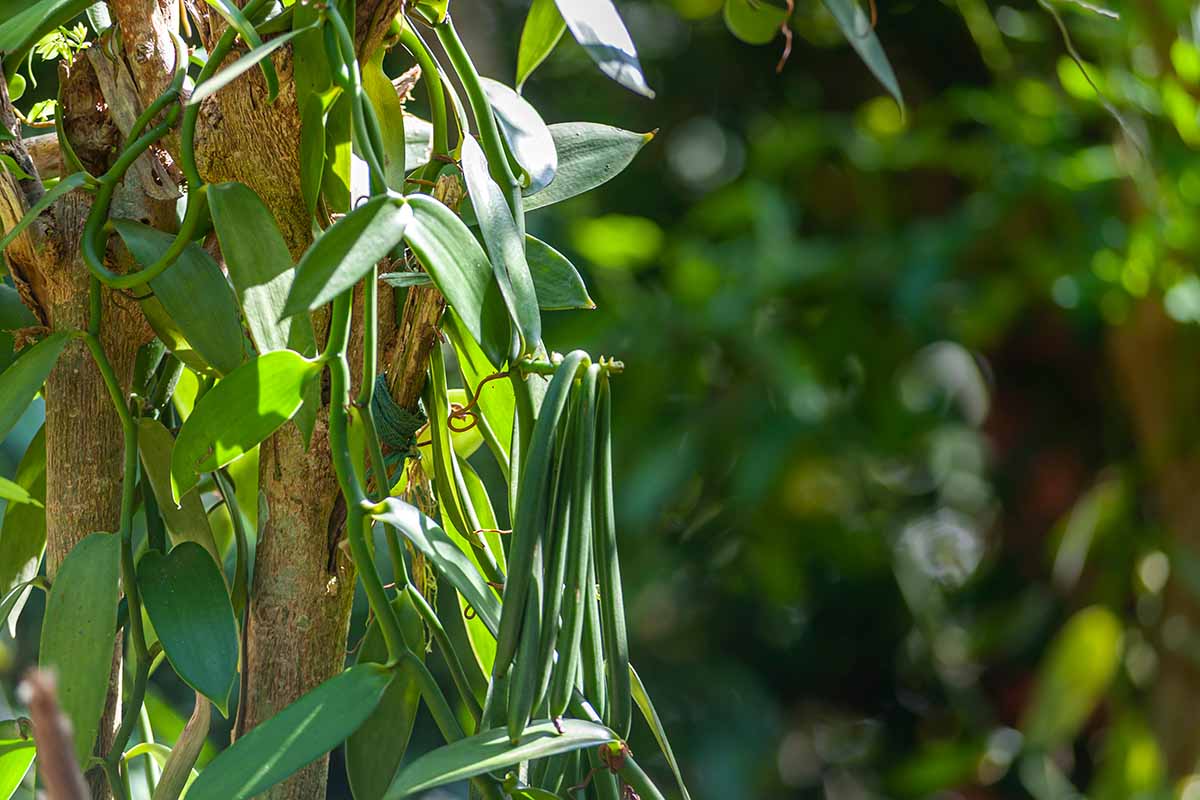
And did you know vanilla pods grow on tropical orchids? I thought that might pique your interest.
For gardeners in warm, humid locations and those equipped with greenhouses, lucky for you, growing your own vanilla orchids is on the menu.
While several species of orchids in the Vanilla genus are used to produce vanilla, V. planifolia is the primary source.
Vanilla orchids are tropical evergreen vines that can reach a staggering 200 feet long. They bear beautiful greenish-cream flowers and glossy green leaves that are lance or oval shaped.
If their flowers are pollinated, they produce seed pods – and that’s where real vanilla comes from, kids!
Growing vanilla beans in the garden year round is an option in USDA Hardiness Zones 10a to 11a.
These tropical vines require trellising, dappled sunlight, excellent drainage, and moist, humid conditions.
And as semi-epiphytes, vanilla orchids can be grown on other fruit trees in the garden, such as avocado trees.
Not sure how to use fresh vanilla in your cooking? Scrape some of the seeds out of the pods and add them to your mixing bowl.
Panna cotta, the Italian gelled cream dessert, is a perfect showcase for high-quality vanilla.
Find a tasty recipe for panna cotta topped with fresh figs on Foodal. Just sub the vanilla extract that it calls for with seeds scraped from about one and a half of your homegrown pods.
Live Vanilla Plant in 6” or 3-Gallon Pot
Are you one of the lucky souls with garden or greenhouse conditions just right to grow your own vanilla pods to use as spice?
You can find live vanilla plants in six-inch or three-gallon pots available for purchase from Fast Growing Trees.
15. Vietnamese Cilantro
Before we bring this roundup to a close, let’s visit one more hot-weather-loving garden option for fans of a cilantro-type flavor.
Vietnamese cilantro (Persicaria odorata) is a sub-tropical or tropical herb also known as “rau ram,” “Vietnamese coriander,” and “Vietnamese mint.”
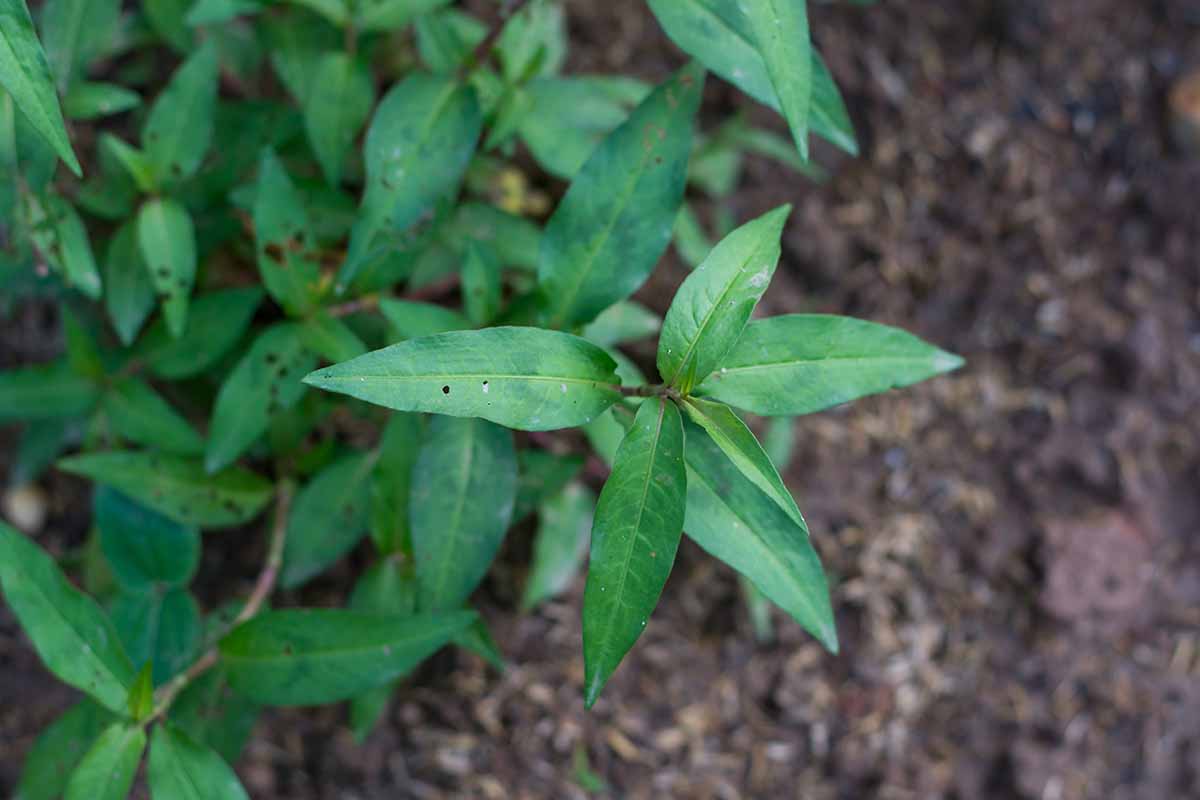
This member of the buckwheat family or Polygonaceae counts plants such as rhubarb, sorrel, and the infamous weed and incredible medicinal, Japanese knotweed, among its relatives.
Vietnamese coriander is an herb that has lance-shaped leaves that are green with splotches of maroon. It grows six to 12 inches in height with a spread of six to 18 inches.
In the garden, grow Vietnamese cilantro in part shade, in moist, well-drained soil. You can treat this herb as a perennial in USDA Hardiness Zones 9b to 12b.
Harvest these tropical herbs sparingly until they get established – since the leaves are pungent, you’ll only need a few at a time anyway.
Vietnamese cilantro has a flavor similar to cilantro, but sharper. It’s widely used in cuisines of Southeast Asia, including those of Malaysia and Indonesia.
Why not try the shredded leaves of this tropical herb mixed into an Asian-style salad tossed with soy sauce and vinegar?
This tropical herb is not usually sown from seed, so look for live plants for your garden.
Lush Seasonings from the Tropics
With 15 ideas to add tropical herbs and spices to the garden, I can’t wait to hear about the beautiful, fragrant, and above all tasty seasonings you’ll grow!
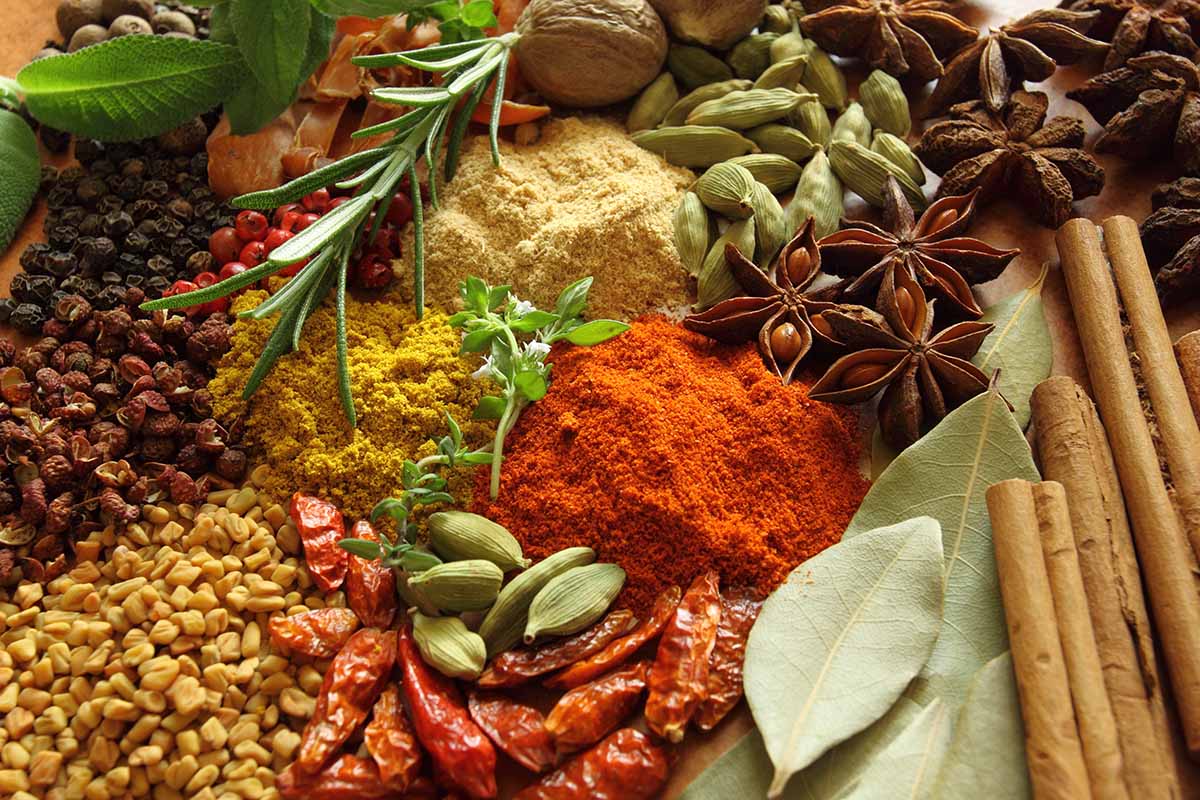
Are you growing any of the plants featured in this article at home? If so please share your experiences with our readers – just leave us a note in the comments section below. And let us know how you like to cook them up!
After stocking your mental pantry with all of these tropical herbs, are you ready to learn more about growing your own herbs and spices? Keep reading right here:
